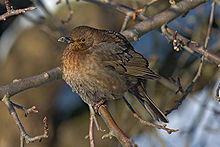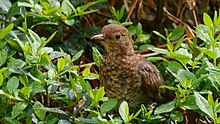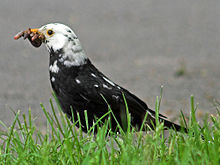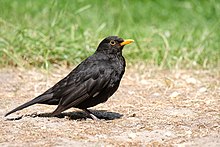Common blackbird
![]()
The title of this article is ambiguous. For other meanings, see Blackbird (disambiguation).
The blackbird (Turdus merula) or blackbird is a species of bird in the thrush family (Turdidae). In Europe, the blackbird is the most widespread representative of this family and at the same time one of the best-known birds of all. Its body length is between 24 and 27 centimetres. The males are black and have a yellow bill, the plumage of the females is mostly dark brown. The melodious and loud territorial song of the males can be heard in Central Europe mainly between the beginning of March and the end of July and can begin before dawn.
The breeding range in Europe has no major distribution gaps except for the far north and the extreme southeast. In addition, the blackbird occurs in parts of North Africa and Asia. In Australia and New Zealand, the blackbird has become naturalized. In Central Europe, some of the birds leave the breeding area in winter and migrate to Southern Europe or North Africa.
Originally, the blackbird was a bird of the forest, where it can still be found today. In the 19th century, it began to penetrate into urban centres via parks and gardens close to settlements and has become a cultural successor. Blackbirds forage mainly on the ground. They feed mainly on animal food, mostly earthworms or beetles. Depending on availability, the proportion of berries and fruits eaten increases. Blackbirds are free breeders and nest mainly in trees and shrubs.
Appearance and characteristics
Adult blackbirds show a clear sexual dimorphism: The plumage of males is solid black, and the bill is conspicuously pale yellow to orange. In addition, males show a distinct ring around the eyes, the color of which resembles that of the beak, but can go somewhat brownish. This eye ring contrasts strongly with the dark brown iris. This eye ring is less distinct in the female, and the bill is also less conspicuous and light horn-colored instead of yellow. The plumage colouring of the female is much more variable and predominantly dark brown, sometimes going into grey or reddish brown. In both sexes the barrel and toes are dark brown. Compared to the smaller starling, which also has dark plumage and often stays on the ground, the blackbird has a much longer tail.
Plumage of adult blackbirds
The plumage of adult males is quite uniformly black. Especially on the underside, but also on the back and shoulder region, the feathers not infrequently show a grey to bronze-coloured terminal fringe, which is, however, quite inconspicuous and only makes a slightly scaly impression in favourable light conditions. The wing feathers can appear bleached out in spring.
The upper side of the females is dark olive-brown to olive-gray colored, the forehead often somewhat less dark. The coloration of the lighter underside is individually very different. The chin and throat are light dirty grey to reddish brown with dark stripes. The chest is brown-grey, yellow-brown to reddish-brown with more or less distinct speckles. The belly is brown, grey-brown or grey, sometimes with a distinctly scaled appearance due to a pale terminal fringe of feathers. The tail feathers are dark to blackish brown, hand and arm feathers dark brown with olive tinted outer plumes.
Young birds and moult
Fledged juveniles resemble females, but are more strongly spotted on the underside and can be recognized above all by the conspicuous light shaft lines on the back, shoulder feathers and wing coverts. The bill is brown. The feathering of wings and tail appears distinct from the rest of the plumage and is dark brown to brown-black in young males, somewhat lighter in females and tending to brown.
During the juvenile moult, which takes place between summer and autumn of the first calendar year, the birds change the small plumage and part of the wing feathers. Thereby, mainly the older young birds change into a so-called progress dress, the later hatched ones into an inhibition dress, in which they continue to resemble rather young birds. The one-year-old males in the inhibition dress are also called mallards. In all one-year-old males, i.e. also the males in progress dress, the wing feathers and the un-moused wing covers are brown in contrast to the brown-black or black colouring of the already moused feather parts. Also in the one-year-old females the already moulted and the unmoulted plumage parts contrast; the latter are clearly lighter.
As a rule, the regular annual moult, which is a full moult, begins two weeks after the young have finished rearing. The moult of a blackbird population extends over a period of five months, excluding extreme cases. In Europe, the moulting period is typically between June and the end of October, with almost all adult blackbirds moulting in August.
Deviating colorations
The drop pattern typical of thrushes is also detectable in blackbirds, but in males it is covered by intense melanin deposits in the feathers. Thus melanism can be considered normal for the species. What is not normal, on the other hand, is the reduction of pigment or the loss of pigment, which can occur in different forms and intensities: Pale colorations (chlorochroism, flavism) are caused by albinism. Completely albinotic white birds with red eyes are unlikely to survive in the wild because of their reduced vision. White birds with brown or black eyes are leucistic. Patches are due to attenuated leucism.
In some years, pied animals occur locally clustered. The resulting symmetrical or asymmetrical patterns are extremely variable. On the one hand, this white colouration may apparently be a hereditary or permanent disorder during the creation or development of the follicles. On the other hand, it has been shown experimentally that the white feathers in the plumage may depend on the composition of the diet, especially during the moult. Low-protein diets seem to favour albinism.
Aberrant colorations are observed today mainly in birds in the settlement area, but were known long before blackbirds were found near humans, for example Aristotle already described white blackbirds.
Body measurements and weight
With a body length of between 24 and 27 centimetres, blackbirds of the nominate form are only marginally smaller than the largest Central European thrush species, the mistle thrush. Males are slightly larger than females. The wing length of the male averages 133 mm and 128 mm for the female, roughly corresponding to a wingspan between 34 and 38.5 centimetres. The tail length is between 104 and 116 millimetres.
Weight fluctuations during the year are considerable in European blackbirds. In multi-year surveys conducted in the UK, weights ranged from 71 to 150 grams, with adult males averaging 102.8 grams and adult females slightly lighter at 100.3 grams. One-year-old birds averaged just under 3 grams lighter. Throughout the year, females are slightly heavier than males only during the laying season. Central European blackbirds have their greatest weight in January and their lowest in July or August, after the breeding season. The weight gain results from the build-up of fat reserves.

Fluffy female

The plumage of a branchling

Leucistic male

Adult male blackbird
Sound Expressions
The territorial song of the male blackbird, audible from afar in spring, is familiar to many people. The blackbird is considered particularly creative in inventing, combining and varying motifs. The melodious verses sound catchy and pleasing to human ears, quite unlike the clamour ("dackderrigigigi duck duck") or "tixen" - a string of high-pitched "tix" sounds heard by both sexes when excited.
Territorial Song
The territorial song is usually performed by the male from two to three different, exposed singing places, which are changed from time to time. One stanza of this song lasts on average a little more than two seconds. During the breeding season, blackbirds give an almost continuous succession of such stanzas for 20 to 30 minutes at dawn, the pauses between stanzas averaging about three seconds. During the evening song the pauses are somewhat longer.
A stanza can be divided into a motivic part and a quieter, more chirping and noisy "appendage". The motif part is somewhat longer, the appendage can also be missing. The motive part, in turn, can be subdivided into elements, usually from two to five, sometimes up to nine. The pauses between the elements, which are about 0.2 seconds long, are audible. The elements are combined to form motifs, and males not infrequently have more than 30 motifs in their repertoire, with two to five favourite motifs, so that even to human hearing it is possible to identify an individual by its song. With the appendage there are even more variations than with the motif part. The frequency spectrum of the appendage is much broader, the main intensity is above 10 kHz, while in the motif part it is between 1.5 and 3 kHz. Technical analysis of the appendage revealed diplophony and opposite frequency responses. Typical for blackbirds is the so-called counter-song, i.e. the mutual response of two neighbouring blackbird males to the verse of the other. The birds pick up the motifs of the counterpart and retort in comparable length and often with similar verse.
The song is partly innate, because the performance of males raised in isolation matches that of conspecifics in many details. Many song elements are adopted by blackbirds from their father and from other males. But also vocalizations of other bird species are imitated, for example titmouse sounds or the laughter of gray and green woodpeckers. Blackbirds in urban areas also include sounds of civilization, such as siren signals of emergency vehicles, in their song.
The first regular territorial song can be heard in central Europe as early as February, with the majority of blackbirds beginning in mid-March, peaking between May and June, especially in warm, humid weather. This phase of song activity ends in mid-July, but especially in settled areas there are reports of blackbirds singing loudly in autumn and also in winter, mainly in mild weather. In spring, blackbirds are among the first songbirds, beginning to sing well before dawn. The second singing maximum is in the evening. In the settlement area, blackbirds are also reported to sing at night, even in winter.
Calls and other singing
One of the best known of the blackbirds' numerous excitement and vocalization sounds is the tixen. This sequence of rapid, sharp sounds animates conspecifics to join in and is often heard in conjunction with communal hating of magpies or cats. Tixing can change to clamouring when even more excited. Clamor may also be directed at conspecifics. Clamouring blackbirds do not show any readiness to flee, but try to drive away competitors or enemies. A very high-pitched, piercing and loud "ssiih" (dropping from 9 to 7 kHz) serves as a warning against enemies, usually in case of danger from the air.
Females sometimes let muffled, but otherwise the male song similar stanzas heard, for example when nest approach or stimulated by the song of the male. For mating, females call with incoherent, very quiet, pressed-sounding and often high-pitched sounds.
After the breeding season, older males with closed beaks perform a special autumn song, which is clearly quieter than the song in spring, but similar to it. The autumn song is also reminiscent of the juvenile song. The latter is innate to both males and females and begins quite suddenly from day 19. During this, the throat, body, and tail vibrate, and the bill is closed or only slightly open. Somewhat older, practicing young male blackbirds can be distinguished from adult blackbirds by their choppy delivery.

Sonagram of a verse of the territorial song, the motif part is about 2.2, the appendage about 0.6 seconds long (sound sample; MP3; 71 kB)
Questions and Answers
Q: What is the common name for the Old World group of birds?
A: The common name for the Old World group of birds is "blackbird".
Q: What is the Latin name for thrush?
A: The Latin name for thrush is Turdus.
Q: What type of species does this group include?
A: This group includes a type species called the mistle thrush.
Q: How do we distinguish this type species from other sub-species?
A: We distinguish this type species from other sub-species by calling it the mistle thrush.
Q: Are all blackbirds part of this Old World group?
A: Not all blackbirds are part of this Old World group, as there are at least two different groups of birds that use the same common name.
Q: Does Turdus refer to only one bird species?
A: No, Turdus refers to multiple bird species within the genus, including but not limited to thrushes.
Search within the encyclopedia